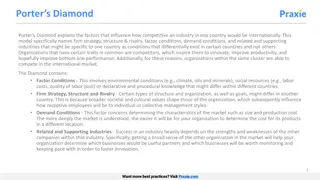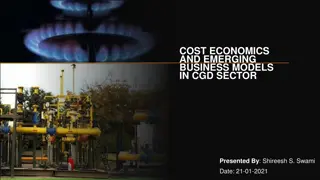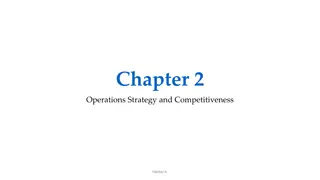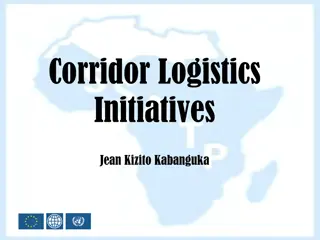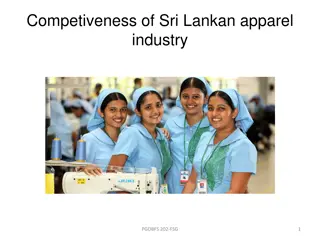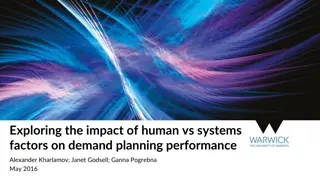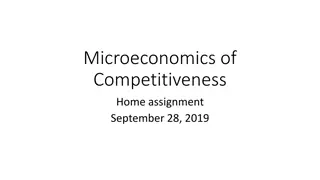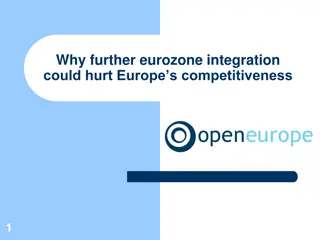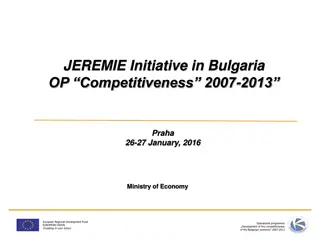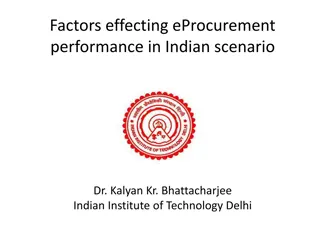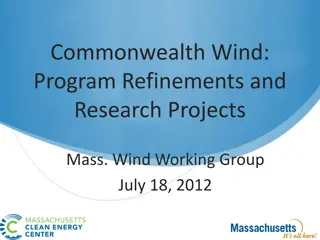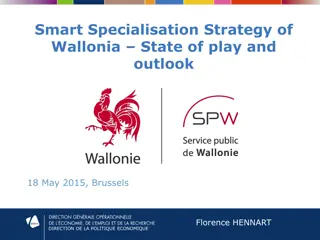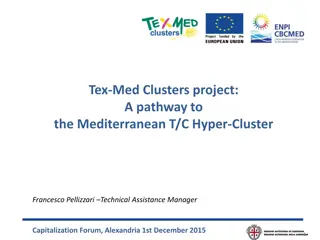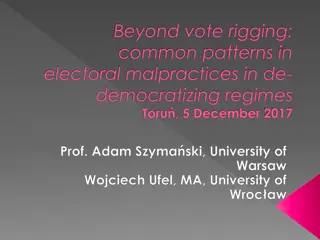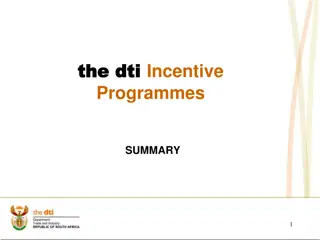Enhancing Research Competitiveness through EPSCoR Program
The EPSCoR Program aims to enhance research competitiveness by investing in STEM capacity and capability in targeted jurisdictions. It prioritizes sustainable growth, infrastructure investments, scholarships, partnerships, and capacity building activities. EPSCoR institutions receive a percentage of funds allocated to research and education programs, supporting a diverse portfolio of investments from talent development to local infrastructure.
Download Presentation

Please find below an Image/Link to download the presentation.
The content on the website is provided AS IS for your information and personal use only. It may not be sold, licensed, or shared on other websites without obtaining consent from the author.If you encounter any issues during the download, it is possible that the publisher has removed the file from their server.
You are allowed to download the files provided on this website for personal or commercial use, subject to the condition that they are used lawfully. All files are the property of their respective owners.
The content on the website is provided AS IS for your information and personal use only. It may not be sold, licensed, or shared on other websites without obtaining consent from the author.
E N D
Presentation Transcript
NeTS EPSCoR Webinar Tuesday, February 13, 2024
Agenda EPSCoR CISE & NeTS Core Small Program Resources Supplements Other Notable Solicitations Q&A 2
EPSCoR 3
Program to Stimulate Competitive Research (EPSCoR) Program Pursues a mission to enhance the research competitiveness of targeted jurisdictions (state, territory or commonwealth) by strengthening science, technology, engineering and mathematics (STEM) capacity and capability through a diverse portfolio of investments from talent development to local infrastructure. NSF: https://new.nsf.gov/funding/initiatives/epscor/epscor-criteria-eligibility
EPSCoR and CHIPS and Sci Act Sec 10325.a.3(A) To the maximum extent practicable, not less than 15.5 percent in fiscal year 2023, 16 percent in fiscal year 2024, 16.5 percent in fiscal year 2025, 17 percent in fiscal year 2026, 18 percent in fiscal year 2027, 19 percent in fiscal year 2028, and 20 percent in fiscal year 2029, of the amounts appropriated to the Foundation for research and related activities, and science, mathematics, and engineering education and human resources programs and activities, excluding those amounts made available for polar research and operations support (and operations and maintenance of research facilities), shall be awarded to EPSCoR institutions.
Key EPSCoR Highlights from CHIPS & Science Act Prioritize funding and activities that enable sustainable growth in the competitiveness of EPSCoR jurisdictions, including (i) infrastructure investments to build research capacity in EPSCoR jurisdictions; (ii) scholarships, fellowships, and traineeships within new and existing programs, to promote the development of sustainable research and academic personnel; (iii) partnerships between eligible organizations in EPSCoR and non-EPSCoR jurisdictions, to develop administrative, grant management, and proposal writing capabilities in EPSCoR jurisdictions; (iv) capacity building activities for Emerging Research Institutions, Historically Black Colleges and Universities, Tribal Colleges and Universities, and Minority Serving Institutions; and (v) building sustainable innovation ecosystems in EPSCoR jurisdictions
CISE: Computer and Information Science and Engineering The Directorate for Computer and Information Science and Engineering (CISE) advances research, innovation and education in computer science, information science and computer engineering fields. Four divisions/offices: Division of Computer and Network Systems (CNS) <- NeTS is here Division of Computing and Communication Foundations (CCF) Division of Information and Intelligent Systems (IIS) Office of Advanced Cyberinfrastructure (OAC) 8
CISE by the Numbers NSF funds 80% of federally- funded CS in the US at academic institutions. 376 institutions supported $1,012M Enacted FY22 Budget 50 + 2 states and territories funded 6,621 Grad Students 6,466 Proposals evaluated 74 28% Funding rate Minority-serving Institutions (MSIs) with awards 20,390 Individuals from Sr. Researchers to Undergrads 1,780 Awards made 9 All data depicted is for FY 22
NeTS: Networking Technology and Systems The NeTS program seeks to, for example: Advance knowledge about how networks work Increase/optimize the performance (latency, QoS, efficiency), security, functionality etc. of existing networks Create new or improve existing protocols or algorithms for, e.g., routing, traffic engineering, naming, management, etc. Rethink and (re)design Machine learning applied to networking Network components (e.g. add programmability) Network systems (e.g. integration of storage, computers and networks, in- network computing, use of wireless networks for sensing) Next-gen networks (eg beyond 5G) 10
NeTS: Networking Technology and Systems Supports both wired and wireless network systems, from: Local to datacenter to Internet-scale networks, IoT networks, Sensor networks, and Other network systems Supports a variety of funding opportunities and sizes including: CAREER, CRII, Small, Medium and Large core projects Portfolio includes: 432 Active Awards https://www.nsf.gov/awardsearch/advancedSearchResult?ProgEleCode=7363&Bo oleanElement=All&ActiveAwards=true With funding totaling over $220 million 34 Active Awards at 14 institutions in 10 EPSCoR Jurisdictions 11
NeTS: Networking Technology and Systems Current Research Topics AI/ML for networking Programmable networks In-network computing and storage Application-aware networking (e.g. AR/VR) Network management: monitoring, measurement, traffic engineering, etc Network performance (latency, QoS) Network protocols Network verification Network resilience Network security Quantum Networking Optical networks Beyond 5G wireless networks Distributed machine learning in wireless networks MIMO networks THz networking Wireless network protocols and systems Mobile edge computing Network Function Virtualization Wireless spectrum monitoring and measurement Dynamic spectrum allocation and sharing Network Function Virtualization
CISE Core Small Program Overview https://www.nsf.gov/pubs/2023/nsf23561/nsf23561.htm 13
CISE Core Small Program NSF 23-561 Small Projects Up to $600,000 Up to 3 years No Deadlines: Accepted Anytime 14
CISE Core Eligibility Institution Eligibility: US-based Institutions of Higher Education US-based Non-profit, non-academic organizations associated with educational and research activities PI Eligibility: PIs, Co-PIs, and other senior personnel must be in a tenure-track position or have a primary, full-time, paid appointment in a research or teaching position at an eligible institution PIs and Co-PIs are restricted to 2 core proposals per 12-month 15
CISE Core Small Well suited to one or two investigators (PI and one co-PI or other Senior Personnel) and at least one student and/or postdoctoral researcher. Proposals that intersect more than one CISE research program are welcome. CISE Program Officers will consider co-reviewing these proposals as appropriate. Collaborative proposals may include both EPSCoR and non- EPSCoR institutions For collaborative proposals, both institutions submit a proposal For subawards, the subawardee is funded through the leading institution and does not have a separate NSF award EPSCoR institutions as subawardees do NOT count towards CHIPS Act target 16
Proposal Preparation Instructions Title: Be sure to include program acronym and project class (e.g., NeTS: Small: Title) Project Summary: Overview, Intellectual Merit, Broader Impacts, Keywords (3-6 keywords) Project Description: Clear statement of work to be undertaken Must include a section clearly labelled Broader Impacts For NeTS Core proposals, must include an evaluation plan May NOT exceed 15 pages Includes results from prior NSF support if applicable Budget: Total budget, including cloud computing resources, restricted to budget limits for the project class Data Management Plan: How you will provide access to well-documented datasets, modeling and/or simulation tools, and codebases to support reproducibility/replicability of their methods and results for a reasonable time beyond the end of the project lifecycle. 17
Supplementary Documents List of Project Personnel and Partner Organizations (required) Cloud Computing Resources (if requesting) More on this later Collaboration Plans (if applicable) May be provided for Small Must be provided for Mediums and Larges with more than one investigator Broadening Participation in Computing Plan (Required for Mediums and Larges) Letters of Collaboration (if applicable) Embedded REU Supplementary Documentation (if applicable) Other specialized information (if applicable) Example: RUI (Research in Undergraduate Institutions) Example: GOALI (Grant Opportunities for Academic Liaison with Industry) Submission Checklist included in Solicitation 18
Review Criteria Intellectual Merit: potential to advance knowledge Broader Impacts: potential to benefit society Examples: Education, K-12 outreach, broadening participation, addresses a societal issue, potential for technology transfer, impact beyond the research discipline Solicitation Specific: How well does the proposal describes an evaluation plan that assesses and, where appropriate, quantifies the research outcomes? 19
Resources 20
Cloud Resources (CloudBank) Proposals may request cloud computing resources to use public clouds such as Amazon Web Services (AWS), Google Cloud Platform (GCP), IBM Cloud, and Microsoft Azure. These cloud resources will be obtained through CloudBank Requested budget plus requested cloud computing resources cannot exceed budget limit ($600,000 for Smalls) CloudAccess should be included as a keyword on the Project Summary Page A supplementary document is required to detail the request 21
Computing Resources ACCESS: The Advanced Cyberinfrastructure Coordination Ecosystem (ACCESS) project facilitates scientific computing by offering researchers access to advanced computing systems and services. Several of these supercomputers provide access to V100 and A100 GPUs and more. Please see the full list of available resources for more information. All NSF ACCESS resources are centrally allocated and you can start with a Discover or Accelerate request and request a larger one if needed. Chameleon: Chameleon is a large-scale, deeply reconfigurable experimental platform built to support Computer Sciences systems research. It supports a bare metal reconfiguration system giving users full control of the software stack including root privileges, kernel customization, and console access. Please see more information on its hardware on the Chameleon hardware page and request access on their new project page. CloudLab: CloudLab is a flexible, scientific infrastructure for research on the future of cloud computing. It enables researchers to use CloudLab to build their own clouds and experiment with new architectures that will form the basis for the next generation of computing platforms. Please see more information on its hardware on the CloudLab hardware page and request access on their signup page. NRP: The National Resource Platform (NRP) resource is a powerful ~300 node nationally distributed computer system with CPUs, GPUs, and FPGAs, specialized for a wide range of data science, simulations, and machine learning or artificial intelligence. Please see the full list of GPUS available. To request access, follow the directions for starting a new project on the NRP website access page. OSG: The Open Science Grid is a nationally-funded consortium of computing resources at more than one hundred institutional partners that, together, offer a strategic advantage for computing work that can be run as numerous short tasks that can execute independent of one another. Researchers from institutes that are not part of the OSG consortium are also able to apply to the Open Science Pool (OSPool). Please see their list of available GPUs and request access on their application page. 22
Additional Testbeds FABRIC The FABRIC Testbed (https://fabric-testbed.net) provides adaptive programmable research infrastructure for computer science and engineering applications. Each of the 29 FABRIC sites provides large amounts of compute and storage, and are interconnected by high speed, dedicated optical links that allow for experimentation and research at scale for purposes such as networking, cybersecurity, distributed computing, storage, virtual reality, 5G, machine learning, and other science applications. How to use: See Getting Started in the FABRIC Knowledge Base (https://learn.fabric-testbed.net/article- categories/getting-started/) PAWR: Platforms for Advanced Wireless Research Infrastructure Synopsis: The PAWR Platforms (https://advancedwireless.org/) consist of four platforms for exploring wireless networking and communication techniques, systems, and devices. The four platforms are: POWDER (https://powderwireless.net/), a programmable advanced wireless research testbed. Please see the Getting Started section of the POWDER Manual (https://docs.powderwireless.net/getting-started.html) COSMOS (https://cosmos-lab.org/), a software-defined mobile wireless testbed with tightly coupled edge computing. Please see the Getting Started section of the COSMOS Documentation Wiki (https://wiki.cosmos- lab.org/wiki/GettingStarted#start) AERPAW (https://aerpaw.org/), an aerial wireless testbed with UAVs. Please see the AERPAW User Manual (https://sites.google.com/ncsu.edu/aerpaw-wiki/aerpaw-user-manual ARA (https://arawireless.org/), a wireless living lab focused on wireless technologies and their application in precision agriculture. Please see the ARA User Manual (https://arawireless.readthedocs.io/en/latest/) 23
Supplements Both new and existing awards 24
REU: Research Experience for Undergraduates New Proposals or Existing Awards Up to $10,000 per student per year Up to two students per year https://www.nsf.gov/pubs/2024/nsf24048/nsf24048.jsp 25
RET: Research Experience for Teachers New Proposals or Existing Awards Up to $15,000 per K-14 teacher per year Up to two teachers per year Usually for 6-7 weeks during the summer, to create modules and resources for use in their classroom https://www.nsf.gov/pubs/2024/nsf24048/nsf24048.jsp 26
Other Examples Existing Awards Supplemental funding requests to existing CISE awards from EPSCoR institutions to support additional graduate students for expanding and enhancing existing projects. Postdoctoral research and/or cyberinfrastructure professionals supplemental funding requests to existing CISE awards from EPSCOR institutions to expand and enhance existing projects. Career Life Balance Supplements. See PAPPG Chapter II.F.8. May fund additional personnel for situations such as primary dependent care or other family considerations. Open to research awards, postdoctoral fellowships, and graduate research fellowships. 27
Other Notable Solicitations 28
Infrastructure CIRC (Community Infrastructure for Research in CISE) NSF 23-589; Proposal Deadline of September 13 Planning ($50,000 - $250,000), Exploratory Development ($250,001 - $750,000), Medium ($750,001 - $2,000,000), and Grand Award sizes ($2,000,001 - $5,000,000) Funds the planning, creation, and enhancement of research infrastructure for use by communities of researchers in CISE disciplines. CC* (Campus Cyberinfrastructure) NSF 24-530; Proposal Deadline of April 22 and October 15 Five areas: Data Driven Networking Infrastructure, Computing and the Computing Continuum, Network Integration and Applied Innovation, Data Storage and Digital Archives, and Strategy. Many have Campus or Regional Scales. Network Integration and Applied Innovation: The goal is to take advantage of research results, prototypes, and emerging innovations to use them to enable specified researchers in a networking context. 29
Other Programs CPS (Cyber-Physical Systems) NSF 21-551; Proposals accepted until May 30 Small and Medium Supports research on engineered systems with a seamless integration of cyber and physical components, such as computation, control, networking, learning, autonomy, security, privacy and verification, for a range of application domains. SaTC (Safe and Trustworthy Cyberspace) NSF 24-504; Proposals accepted anytime Small and Medium, including Transition to Practice and EDU Supports research addressing cybersecurity and privacy, drawing on expertise in one or more of these areas: computing, communication and information sciences; engineering; economics; education; mathematics; statistics; and social and behavioral sciences. Conference/Workshop Proposals See PAPPG Chapter II.F.9 Travel Grant Proposals See PAPPG Chapter II.F.11 30
NeTS: Networking Technology and Systems - Learning More NeTS Newsletter Sent out ~monthly Includes information about the NeTS program, NeTS community-relevant workshops, new solicitations Information on infrastructure programs (e.g. PAWR, FABRIC, Cloud resources) To subscribe, send an email with no subject line and a body of "SUBSCRIBE NETS-ANNOUNCE Firstname Lastname (without quotes) to listserv@listserv.nsf.gov NSF Email Updates A variety of lists, including NSF Funding Opportunities and Updates for CISE. https://service.govdelivery.com/accounts/USNSF/subscriber/new NeTS Webinars Held periodically, typically to introduce new programs, solicitations, and Dear Colleague Letters (DCLs) Potential Panelist Surveys Wired: https://www.surveymonkey.com/r/WiredPanelAvailability Wireless: https://www.surveymonkey.com/r/WirelessPanelAvailability Talk to Program Directors https://new.nsf.gov/funding/opportunities/cns-networking-technology-systems-nets 32
NeTS Team Ann Von Lehmen, Program Director and Cluster Lead Alhussein Abouzeid, Program Director Darleen Fisher, Program Director Deep Medhi, Program Director Nicholas Goldsmith, Assistant Program Director Murat Torlak, Expert Bryan Lyles, Expert Cassandra Queen, Integrative Activities Specialist and Admin Team lead Pashell Elmore, Student Trainee (Administrative) 33
Questions? Feel free to reach out to Program Directors https://new.nsf.gov/funding/opportunities/cns-networking-technology- systems-nets 34




